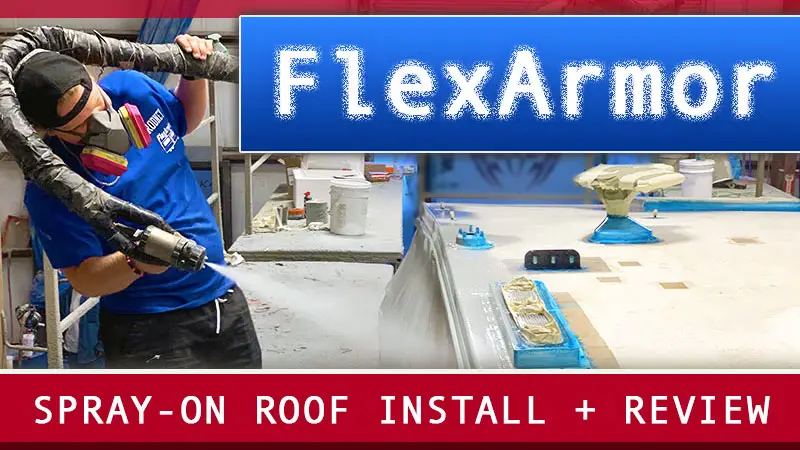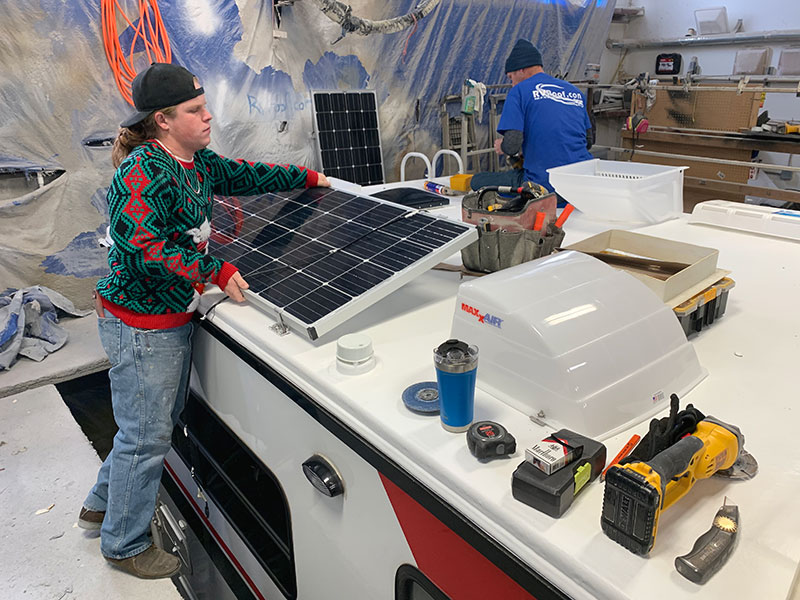Rv Flex Armor has experienced several problems and complaints from customers. Many users have faced issues with the durability and effectiveness of this product, expressing concerns about its long-term performance.
Rv Flex Armor is a popular choice among RV owners for protecting their vehicles from environmental damage, ensuring a long-lasting and attractive appearance. However, some users have reported issues with the adhesion and durability of this product, making it important to address these concerns before making a purchase.
Understanding the common problems and complaints associated with Rv Flex Armor is essential for potential buyers to make an informed decision and ensure the best protection for their RV. Let’s explore the specific issues and potential solutions to improve the overall performance and satisfaction with this product.


Credit: issuu.com
Understanding Rv Flex Armor
What Is Rv Flex Armor?
Rv Flex Armor is a groundbreaking protective coating specifically designed for RVs. It is a liquid-applied, spray-on product that forms a durable, seamless, and waterproof membrane over the entire surface of the RV’s roof. This innovative solution provides long-term protection against water infiltration and damage, ultimately increasing the lifespan of the RV.
How Is Rv Flex Armor Applied?
Applying RV Flex Armor involves a meticulous process that begins with the cleaning and preparation of the RV’s roof surface. Once the surface is properly prepped, the Flex Armor liquid coating is sprayed onto the roof, creating a uniform and flexible layer. This application is carefully executed to ensure complete coverage and optimal performance of the product.
Common Problems With Rv Flex Armor
When it comes to RV Flex Armor, while it offers durability and protection, it’s not immune to issues. Understanding the common problems associated with RV Flex Armor can help RV owners be proactive in addressing and preventing potential issues.
Leaks And Water Damage
Leak and water damage are persistent issues with RV Flex Armor. Improper installation or insulation and seams not properly sealed can lead to water seepage, causing long-term damages to the structure and interior of the RV.
Cracks And Peeling
Cracks and peeling are frequent complaints when it comes to RV Flex Armor. Extreme temperatures and weather conditions, as well as inadequate surface preparation, can lead to the development of cracks and peeling, compromising the protective properties of the coating.
Improper Application
Improper application of RV Flex Armor is another common issue. Inexperienced or rushed application can lead to uneven coating, which not only affects the aesthetics but also diminishes the protective capabilities of the Flex Armor, leaving the RV vulnerable to damage.
Customer Complaints
If you’ve encountered issues with RV Flex Armor, we understand your frustration. Our team takes customer complaints seriously and is committed to addressing any problems with our product. Your feedback helps us improve and ensure a better experience for all our customers.
Feedback And Reviews
Customers have expressed their concerns and frustrations with RV Flex Armor through various feedback and reviews.
Issues Faced By Rv Owners
- Leaking roofs causing water damage issues.
- Poor installation resulting in leaks and cracks.
- Delays and poor customer service when addressing complaints.
Impact On Rv Owners
RV owners invest a significant amount of money in their vehicles, seeking enjoyment and comfort during their travels. However, when it comes to the installation of RV Flex Armor, some problems and complaints have been reported. Let’s explore how these issues can impact RV owners in terms of financial costs, safety concerns, and aesthetics and resale value.
Financial Costs
RV Flex Armor problems and complaints can lead to unforeseen financial costs for RV owners. Firstly, if the installation does not meet the desired quality standards, repairs or reinstallation may be required. This can result in additional expenses, especially if the installation was conducted by a non-certified or inexperienced technician.
Moreover, unreliable or defective RV Flex Armor can cause water leaks, leading to damage within the RV. Such leaks can damage flooring, furniture, electrical systems, and other internal components. Repairing this damage can be quite costly, as it often requires hiring professionals and purchasing replacement parts.
Additionally, if the RV Flex Armor fails to provide the promised durability and protection, it may not withstand the wear and tear of regular use. This can result in early degradation of the coating, necessitating reapplication or replacement, further stretching the financial burden.
Safety Concerns
Safety concerns arising from RV Flex Armor problems and complaints are an additional worry for RV owners. Leaking water due to poor installation or product quality can create a breeding ground for mold and mildew. These harmful organisms can jeopardize the air quality inside the RV, potentially causing respiratory issues for those traveling or residing in it.
Moreover, if water leaks seep into the internal electrical systems, it can lead to short circuits or even fire hazards. This poses a grave threat to the safety of the RV occupants, not to mention the potential damage to personal belongings.
It is essential for RV owners to thoroughly assess the reliability of the RV Flex Armor and ensure it meets stringent quality standards to mitigate safety risks.
Aesthetics And Resale Value
Aside from financial and safety implications, RV Flex Armor problems can also impact the aesthetics and resale value of the vehicle. Unsightly works, such as visible seams or uneven application, can significantly detract from the overall appearance of the RV.
When it comes to selling or trading in the RV, potential buyers are likely to be discouraged by the presence of visible flaws in the RV Flex Armor. A diminished resale value may result from the need to invest in repairs or corrective measures, creating a disadvantage for RV owners who wish to upgrade or sell their vehicle.
Furthermore, unsatisfactory performance of RV Flex Armor can undermine the perception of the RV’s quality, potentially influencing potential buyers to look for alternative options in the market.
In conclusion, RV Flex Armor problems and complaints have a tangible impact on RV owners. Financial costs, safety concerns, and the effects on aesthetics and resale value all contribute to the overall negative experience. Thus, it is crucial for RV owners to conduct thorough research and choose a reliable and reputable service provider when opting for RV Flex Armor installation.
Resolving Rv Flex Armor Issues
RV Flex Armor, a popular coating option for recreational vehicles, is known for its durability and ability to protect against leaks and damage. However, like any product, it is not without its share of problems and complaints. If you find yourself facing issues with your RV Flex Armor, there are several steps you can take to resolve them and get your precious home on wheels back in top shape. In this article, we will explore the options available to you when it comes to overcoming RV Flex Armor problems and complaints, including seeking manufacturer assistance and exploring repair and maintenance options.
Seeking Manufacturer Assistance
When you encounter problems with your RV Flex Armor coating, it is worthwhile to reach out to the manufacturer for support. Many manufacturers are committed to providing excellent customer service and resolving issues promptly. To get started, follow these steps:
- Consult your warranty documentation for contact information
- Reach out to the manufacturer via phone or email
- Clearly explain the problems you are experiencing with your RV Flex Armor
- Provide any necessary documentation, such as photos or videos, to support your claims
- Follow their instructions for further troubleshooting or resolution
Remember, it is important to maintain a calm and professional demeanor when communicating with the manufacturer. They are more likely to assist you if you approach them with respect and clear details about the issue.
Repair And Maintenance Options
If the manufacturer’s assistance does not fully resolve the problems with your RV Flex Armor, there are still repair and maintenance options available to you. Consider the following steps to address these issues:
- Consult with a professional RV repair technician
- Request a thorough inspection of your RV’s Flex Armor coating
- Allow the technician to identify any underlying issues and recommend appropriate repairs
- Discuss the repair options, including cost and timeline, with the technician
- Make an informed decision based on the technician’s expertise and your budget
By taking these steps, you can ensure that your RV Flex Armor problems are addressed professionally and efficiently. Remember, regular maintenance of your RV Flex Armor is also crucial to prevent future issues. Follow the manufacturer’s recommended maintenance instructions, such as regular cleanings and inspections, to keep your coating in optimal condition.

Credit: issuu.com
Preventive Measures
Regular Inspections
Regularly inspecting your RV Flex Armor can help catch potential problems early on.
Look for any signs of peeling, cracking, or bubbling in the coating.
- Check for any areas where the coating may have worn away.
- Inspect seams and edges for any gaps or separation.
Proper Application Guidelines
Following the proper application guidelines is crucial in preventing issues with RV Flex Armor.
Ensure that the surface is properly cleaned and prepped before applying the coating.
- Use the recommended tools and techniques for application.
- Allow sufficient drying and curing time between coats.

Credit: www.truckcampermagazine.com
Frequently Asked Questions For Rv Flex Armor Problems And Complaints
What Are Some Common Problems With Rv Flex Armor?
Some common problems with RV Flex Armor include cracking, peeling, fading, and water leakage. These issues can occur due to improper installation, extreme weather conditions, or aging of the RV. Regular maintenance and inspections can help prevent and address these problems.
How Can I Prevent Cracking And Peeling Of Rv Flex Armor?
To prevent cracking and peeling of RV Flex Armor, it is important to ensure proper installation by experienced professionals. Additionally, regular cleaning and maintenance using recommended products can help prolong the life of the coating. Avoid using abrasive materials or harsh chemicals that can damage the surface.
What Should I Do If My Rv Flex Armor Is Fading?
If your RV Flex Armor is fading, consider applying a UV protectant coating specifically designed for RV surfaces. This can help restore and protect the color of the Flex Armor. In some cases, professional touch-ups or reapplication of the coating may be necessary to maintain the aesthetic appeal of your RV.
Conclusion
If you’re considering Rv Flex Armor, it’s essential to be aware of potential problems. Addressing complaints and issues can help you make an informed decision. Prioritize reliability and quality to ensure a positive experience with your RV roof. Stay informed and take proactive steps for a trouble-free journey ahead.